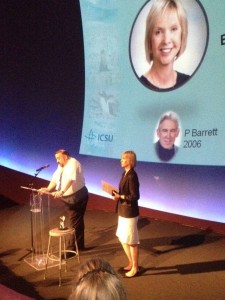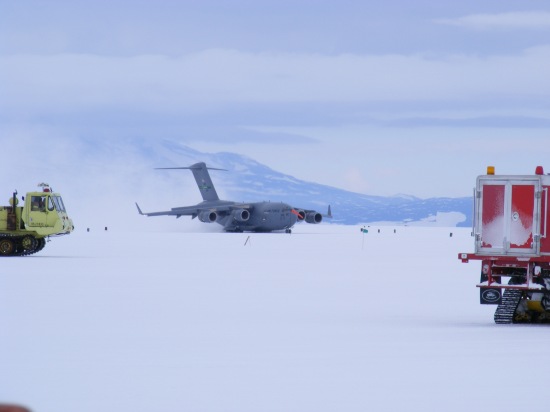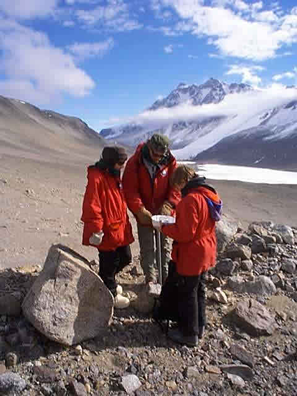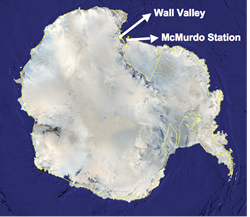The McMurdo Dry Valleys Long-Term Ecological Research (MCM LTER) Program is an inter- and multidisciplinary study of the Antarctic Dry Valleys, an ice-free region of Antarctica along the Ross Sea. MCM joined the National Science Foundation’s LTER Network in 1993 and is funded through the Office of Polar Programs, and studies both aquatic and terrestrial ecosystems.
Grant (MCM IV, NSF OPP 1115245) investigates “Increased Connectivity in a Polar Desert Resulting from Climate Warming: McMurdo Dry Valley LTER Program”
See the Wall Field Teams in Antarctica
In the Antarctic Dry Valleys, climate warming may progress as ozone depletion is ameliorated, resulting in an increase of warm summers that may lead to transient pulse events of high summer melt-flows. The Wall lab’s research examines contemporary patterns in ecological connectivity across the valleys such as the distribution, abundance, and demographics of soil invertebrate species in response to changing environmental conditions.
Recent news…
January 2018: Findings from a long-term field study in the MCM LTER project were published in Ecology. For the press release from Colorado State University click here.
Article reference:
- Andriuzzi, W.S., Adams, B.J., Barrett, J.E., Virginia, R.A., Wall, D.H. (2018) Observed trends of soil fauna in the Antarctic Dry Valleys: early signs of shifts predicted under climate change. Ecology.
Meanwhile, Diana Wall is in Antarctica to conduct fieldwork in the remote Shackleton Glacier. Follow the team’s updates here.
***
August 2017: It has been an exciting week for the Wall lab, with not one, but two high-impact publications on our Antarctic research coming out almost on the same day:
- Knox, M.A., Andriuzzi, W.S., Buelow, H.N., Takacs-Vesbach, C., Adams, B.J., Wall, D.H. (2017) Decoupled responses of soil bacteria and their invertebrate consumer to warming, but not freeze-thaw cycles, in the Antarctic Dry Valleys. Ecology Letters.
- Gooseff, M.N., Barrett, J.E., Adams, B.J., Doran, P.T., Fountain, A.G., Lyons, W.B., McKnight, D.M., Priscu, J.C., Sokol, E.R., Takacs-Vesbach, C., Vandegehuchte, M.L., Virginia, R.A., Wall, D.H. (2017) Decadal ecosystem response to an anomalous melt season in a polar desert in Antarctica. Nature Ecology and Evolution.
Check out our blog (active during the field season) and our LTER website!
Scientists converge at CSU to discuss Antarctic conservation (May 2016)
Local NPR affiliate KUNC featured a story and interview with Dr. Diana Wall about her work on the soils of Antarctica.
The Science Friday segment on NPR (July 20, 2012) featured scientists from the McMurdo Dry Valleys LTER, including Dr. Diana Wall!
There was a press conference on Monday, July 23 (2012) to announce the results of the US Antarctic Program’s Blue Ribbon Panel (appointed by the Office of Science and Technology Policy and the National Science Foundation and of which Dr. Diana Wall was a member). Their report “More and Better Science in Antarctica through Increased Logistical Effectiveness,” contains recommendations to increase efficiency and effectiveness to increase scientific research in Antarctica.
Diana Wall is a co-author on a Science policy letter title Challenges to the Future Conservation of the Antarctic released on July 12, 2012.
— Our Amazing Planet has an article covering this important paper!
There was a workshop on July 14 and 15 (2012), just prior to the SCAR meeting about the McMurdo Dry Valleys Terrestrial Observation Network. The PI of this workshop is Dr. Byron Adams (Brigham Young) and co-PIs are Dr. Diana Wall (Colorado State), Dr. Ian Hogg (Waikato) and Dr. Jeb Barrett (Virginia Tech).
The workshop is intended to provide a draft plan that will serve as a first step in establishing a coordinated, long-term observation network for the McMurdo Dry Valleys. The goal is to have an established network that will facilitate increased coordination and comparability of measurements of the key processes associated with environmental change, including those involving biota, human movement, and climatic parameters that can inform predictions of how organisms and ecosystems will be altered with environmental change. This workshop will also serve as a visioning effort to determine the types of data needed to determine the effects of climate change on Antarctic terrestrial and aquatic ecosystems. Another intended outcome is an expanded capacity for assessing and improving management and environmental protection programs.
Dr. Wall was awarded the 2012 SCAR President’s Medal for Excellence in Antarctic Research for her contributions to Antarctic science and advice on policy. She will receive the award at the 2012 SCAR Open Science Conference in July.
There is a video showing two months timelapse of Wormherder Creek (by Lake Bonney in Taylor Valley) from the field season of 2010-2011.
Our previous research focus (for MCM III) was: The Role of Natural Legacy on Ecosystem Structure and Function in a Polar Desert
Antarctic soils are the oldest, coldest, and driest on Earth and share similarities with the arid soils of the Jornada and Sevilleta LTER sites. The soils found in the McMurdo Dry Valleys are poorly developed, coarse-textured, and often have high salinities. They also have the lowest organic carbon and biological activity of any soils on this planet.
The physical and chemical environment of Antarctic soils varies along gradients of temperature, moisture, organic matter content created in part by legacies of past climates.
No other soil systems are known to exist in which nematodes represent the top of the food chain and where food webs are as simple in structure. The nematode community in MCM soils consists of an endemic species Scottnema lindsay , a microbial feeder (bacteria and yeast), Plectus antarcticus, a bacterial feeder, and Eudorylaimus antarcticus, an omnivore-predator. Because nematodes are aquatic animals, moisture is a more important factor for survival in Antarctica than low temperature. Moisture from melting snow and streams is available to soils only intermittently, so organisms must be capable of prolonged survival with limited moisture and temperatures below freezing. Nevertheless, nematodes are ideally suited for survival in this extreme environment. They can enter a survival state, anhydrobiosis, for extended periods. This effectively decouples them from the nutrient cycle, which may contribute to the extremely slow rate of nutrient and carbon exchange in the MCM.
Wall Valley
”’Wall Valley”’ (77deg 29″S 160deg 51E) is an upland valley next east of Priscu Valley in the Olympus Range of Antarctica; Minotaur Pass is at the head between Apollo Peak and Mount Electra. The valley opens north to McKelvey Valley. Named by the ICSU Scientific Committee on Antarctic Research (SCAR) in 2005 after Diana Wall, of the Natural Resources Ecology Laboratory, Colorado State University, Fort Collins, CO; Wall has been a soils biologist in the McMurdo Dry Valleys since 1989.



